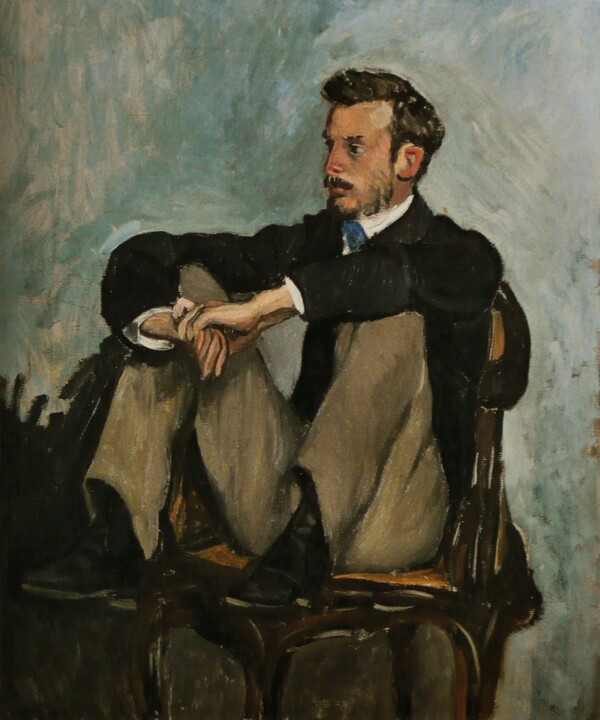 Frédéric Bazille, Portrait of Renoir (1867), Montpellier (France), Fabre museum
Frédéric Bazille, Portrait of Renoir (1867), Montpellier (France), Fabre museum
Auguste Renoir was a 19th century French painter, born in 1841 and died in 1919. He is considered one of the most important exponents of Impressionism, an artistic movement characterized by the use of vivid colors, brushstrokes visible and natural light.
Renoir is particularly known for his paintings of nudes, scenes of daily life and landscapes, as well as for his portraits. He began his career as a porcelain painter before turning to oil painting. His most famous works include "Le Déjeuner des Boatiers" and "Bal du moulin de la Galette". Renoir also had a great influence on many other artists, including Pablo Picasso and Henri Matisse.
The beginnings of the artist
Auguste Renoir was born in 1841 in Limoges. He comes from a family of craftsmen and is the sixth of seven children. In 1844, the family moved to Paris to improve their financial situation. Renoir continued his schooling there and became an apprentice at the Lévy Frères & Compagnie porcelain workshop at the age of 13. He also took drawing and decorative arts lessons, as well as music lessons with Charles Gounod. At the age of 17, Renoir began to earn a living by painting fans and coloring coats of arms for his brother. In 1862, he entered the School of Fine Arts in Paris and joined Charles Gleyre's studio, where he met Claude Monet, Frédéric Bazille and Alfred Sisley. The group became friends and often painted outdoors. After leaving the School of Fine Arts, Renoir's first work exhibited at the Salon, the Esméralda, was a great success, but he decided to destroy it after the exhibition. His works from this period are influenced by Ingres, Dehodencq, Courbet and Delacroix. His mistress Lise Tréhot is an important model for him and posed for his painting Lise à l'ombrelle. Two children are born of their affair.
Impressionism
Renoir's stay with Monet at La Grenouillère was decisive in his career. He learned to paint in the open air, to render the effects of light and to no longer use black for shadows, which marked the beginning of his Impressionist period. During the Franco-Prussian War, he was mobilized and fell seriously ill and was hospitalized in Bordeaux before being demobilized in March 1871 and returning to Paris, where he learned of the death of his friend Frédéric Bazille. In 1873 he left his studio for a larger studio and in 1876 he rented a modest studio which would later become the Musée de Montmartre in 1960.
Renoir exhibited with the Impressionists from their first exhibition in 1874 and that of 1878. In 1876, he produced his masterpiece, the Bal du moulin de la Galette, which was bought by Gustave Caillebotte, member and patron of the group. This ambitious canvas is characteristic of the artist's style during the 1870s, with a fluid and colorful touch, colored shadows, an absence of use of black, textural effects, a play of light and a predilection for scenes. of popular Parisian life and the models of his entourage. For the nudes, he first calls on professional models and then on young women whom he sometimes meets in the street and whom he remunerates by offering them portraits, flowers or fashionable hats.
Renoir leaves the Impressionist group
Around 1880, Renoir went through a difficult period where he struggled to sell his paintings and where the critics were hardly laudatory. He then decides to leave the Impressionist group to exhibit at the Official Salon, which is considered the surest path to success. He finally achieved a certain recognition thanks to commissions for prestigious portraits, such as that of Madame Charpentier and her children in 1878. His art also evolved towards a more assertive search for the effects of lines, marked contrasts and underlined contours, as in the famous Déjeuner des canotiers from 1880 to 1881. Between 1881 and 1883, he traveled extensively in France, North Africa and Italy, where he was influenced by the works of Raphael and began to feel a certain impasse in Impressionism. He then began a so-called “ingresque” period, which culminated in 1887 with the presentation of his Grandes Baigneuses in Paris. The outlines of his characters become more precise and the colors colder, which shocks some critics. When he became a father again in 1885, Renoir devoted himself to paintings on motherhood. The reception of Les Grandes Baigneuses was very poor and Renoir was criticized both by the avant-garde and by academic circles. He finally married Aline Charigot in 1890 after discovering his native village of Essoyes.
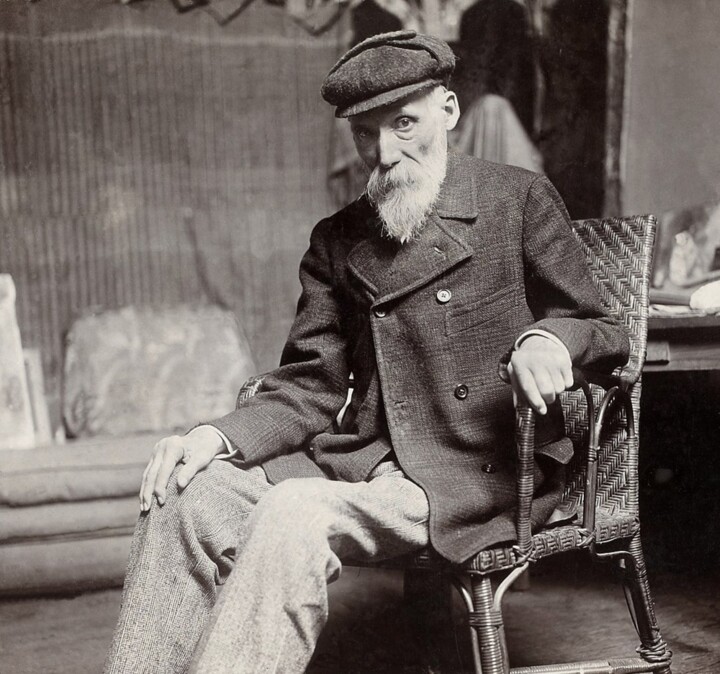 Pierre-Auguste Renoir photographed by Dornac around 1910
Pierre-Auguste Renoir photographed by Dornac around 1910
Renoir changed his style again from 1890 to 1900, towards a more fluid and colorful style. One of his first works from this period, Young Girls at the Piano (1892), was purchased by the French State for the Luxembourg Museum. In 1894, Renoir was again the father of a little Jean and resumed his maternity works. Gabrielle Renard, Aline's young cousin who took care of Jean then Claude, born in 1901, became one of her favorite models and her muse. He also has a pupil, Jeanne Baudot, the daughter of his doctor. In 1896, Renoir bought a house in Essoyes, which became the Renoir studio. This is where the family gathers every summer. This decade is that of consecration, his paintings sell well, the critics begin to appreciate his style. Official circles also recognize him, he is offered the Legion of Honor, which he first refuses and then later accepts.
In 1897, he fractured his right arm in a fall from a bicycle near Essoyes, which is considered responsible for the subsequent deterioration of his health. He donated La Balayeuse for the sale organized by Monet in 1899 for the benefit of the children of Sisley. In 1900, he was named Chevalier of the Legion of Honor, then promoted to officer in 1911. He also joined the Ligue de la patrie française, an anti-Dreyfusard nationalist league.
In 1903, Renoir moved with his family to Cagnes-sur-Mer for health reasons. He acquired the Domaine des Collettes to save the olive trees threatened with destruction and built his last home there. His works from this period are portraits, nudes, still lifes and mythological scenes, with shimmering and sensual female bodies. He continues to paint despite deforming rheumatism which forces him to give up walking. Renoir was then a major figure in the world of Western art, exhibiting all over Europe and the United States and trying new techniques, including sculpture despite his hands deformed by rheumatoid arthritis. He is friends with the painter Lucien Mignon and Ferdinand Deconchy. Renoir died in 1919 in his house in Les Collettes, having left behind him a considerable artistic heritage. Renoir, continued to work until his death in 1919 despite the difficulties of the First World War. His wife, Aline, died in 1915, and his sons, Pierre and Jean, were seriously wounded in action but survived. Renoir even painted a bouquet of flowers on his deathbed before he died of pulmonary congestion in 1919. Originally buried with his wife in Nice, their burial place was transferred to Essoyes according to their wishes. The ashes of Dido Renoir, Jean's second wife, were also placed in the same grave.
The sculptor
Between 1913 and 1918, Renoir collaborated with the young sculptor Richard Guino and created major pieces such as Venus Victrix, the Judgment of Paris, the Great Washer and the Blacksmith. Guino is recognized as co-author of these works after a lawsuit in 1973, which highlighted the importance of his contribution. This collaboration was unique because Guino was not simply a practitioner reproducing the existing model, but a true co-creator, transposing the spirit of Renoir's painting into his sculptures. Later, Renoir worked with the sculptor Louis Morel and produced the terracottas, two dancers and a flute player.
The main works of Renoir
Pierre-Auguste Renoir painted a considerable number of works during his artistic career, although the exact number is not known. It is estimated that he created around 4000 paintings, including portraits, landscapes, nudes, genre scenes and mythological compositions. He also produced ceramics, prints and sculptures.
Bal du Moulin de la Galette (1876): an oil on canvas depicting a scene of Parisian life in the 19th century, depicting a ball at the Moulin de la Galette, located in the Montmartre district. The composition and colors are typical of Renoir's Impressionist style.
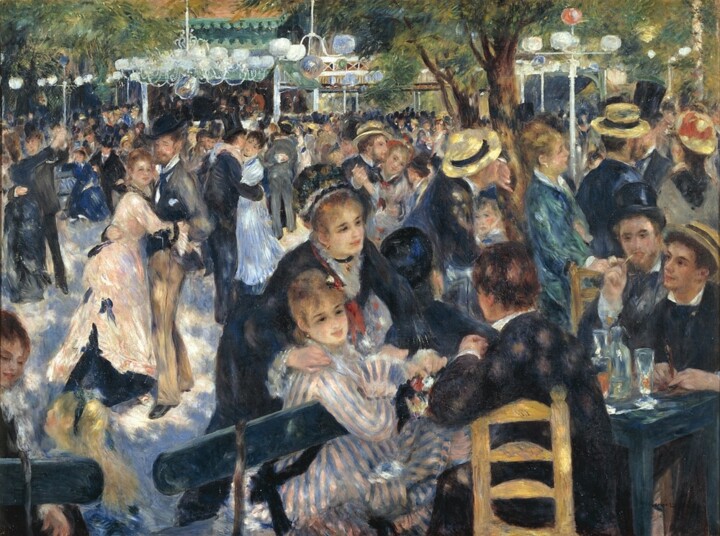
Ball at the Moulin de la Galette, Oil on canvas, Musée d'Orsay, ParisLes Canotiers à Chatou (1879): a leisure scene on the Seine with boaters and women in summer dresses. Light and color are used to capture the sunny atmosphere of the day.
Le Déjeuner des Canotiers (1881): a group scene showing Renoir's friends having their meal at the Maison Fournaise inn in Chatou. The figures are laid out informally, creating a sense of life and movement.
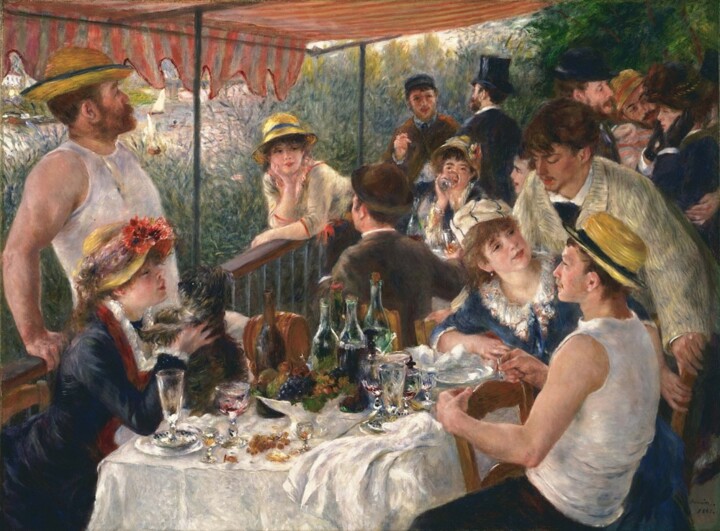
The Boating Party's Luncheon (1881), Washington, The Phillips CollectionLa Grenouillère (1869): a painting that shows a popular bathing scene on the Seine. The composition is light and elegant, with particular attention paid to the effects of light on water.
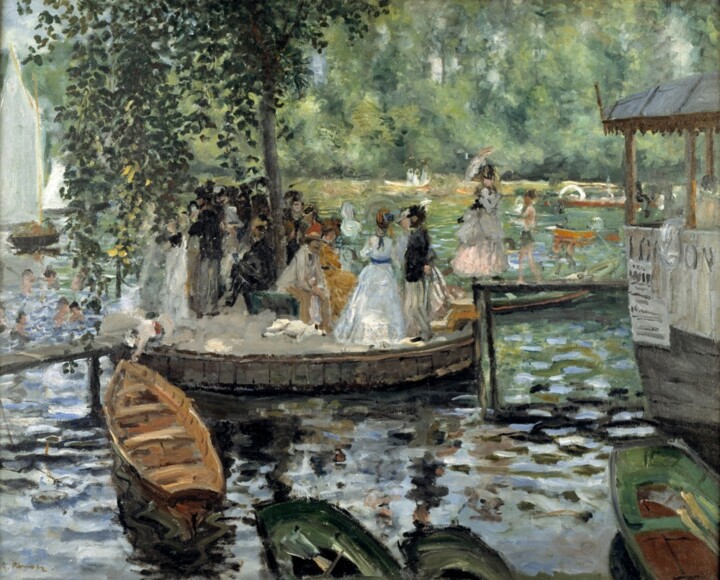
La Grenouillère, Oil on canvas, Nationalmuseum, Stockholm (Sweden)Young Girls at the Piano (1892): a painting of two young women playing the piano in an elegant salon. The color palette is soft and the figures are depicted with great attention to detail in their clothing and postures.
- Les Grandes Baigneuses (1887): a bathing scene with several naked women in a wooded clearing. The colors are rich and saturated, creating an impression of luxury and sensuality.
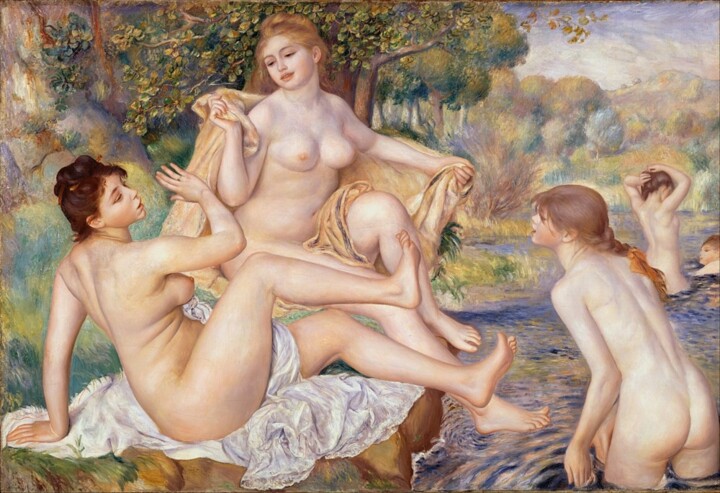
The Large Bathers (1887), Philadelphia, Philadelphia Museum of Art Naked woman combing her hair (1894): an oil on canvas showing a naked woman combing her hair in front of a mirror. The colors are soft and the composition is simple but elegant.
La Danse à la Campagne (1883): an outdoor dance scene in a meadow. The colors are clear and bright, with particular attention paid to the movements and expressions of the dancers.
La Balançoire (1876): an outdoor painting that shows a woman seated on a swing, with two men at her side. The composition is light and cheerful, with great attention paid to the effects of light on the figures.
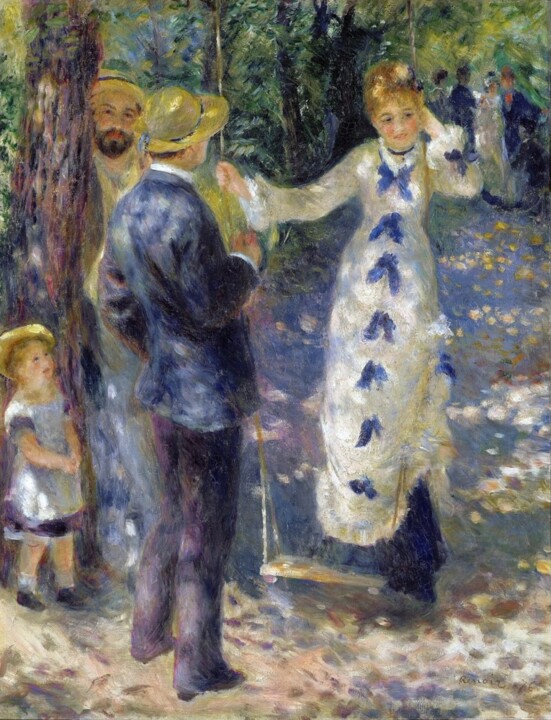 The Swing, oil on canvas, Musée d'Orsay, Paris (France)
The Swing, oil on canvas, Musée d'Orsay, Paris (France)The Two Sisters (1881): an oil on canvas showing two young girls in white dresses standing in a garden. The composition is simple and elegant, with soft and bright colors that create an impression of calm and harmony.

The Two Sisters or On the Terrace (1881), oil on canvas, Art Institute of Chicago, Chicago (United States)
Renoir's influences
French composer Claude Debussy said Renoir's paintings influenced him in the composition of his music, particularly in his famous Prelude to the Afternoon of a Faun.
French filmmaker Jean Renoir, son of Pierre-Auguste, was influenced by his father's paintings in the way he filmed and composed his shots. He notably directed the film "La Grande Illusion", which was inspired by Renoir's paintings of war.
American photographer Richard Avedon created a series of photos in homage to Renoir, entitled "In the American West". He used the same color palette and sense of light as Renoir to photograph workers in rural America.
French couturier Christian Dior was inspired by Renoir's dresses and colors for his 1947 haute couture collection, which marked the beginning of the "New Look" era.
The French poet Guillaume Apollinaire wrote several poems in homage to Renoir, notably "Le Bestiaire ou Cortège d'Orphée", in which he evokes the lightness and grace of the women represented in Renoir's paintings.
French furniture designer Emile-Jacques Ruhlmann has created a series of furniture inspired by the shapes and colors of Renoir's paintings.
Quotes from Renoir
- “Painting has no other purpose than to convey an emotion. »
- “You have to paint first, think afterwards. »
- “A young painter should not worry about color. He must be concerned with the form. »
- “Work removes the most bitter tastes. »
- “Painting must above all please, delight the eye. It is made for this. »
- “Nature is not in itself picturesque. It becomes so under the action of art. »
- “I never wanted to be anything other than a painter of modern life. »
- “You have to paint the surrounding air as you feel it, respecting the laws of perspective, and not reproducing formulas that refer only to the imitation of nature. »
- " Reality does not exist. There are only impressions. »
- “When you know how to draw, you can do anything else. »
Renoir's major exhibitions
There have been several major exhibitions dedicated to Renoir around the world:
“Renoir, 1841-1919”, organized by the Réunion des musées nationaux and the Musée d'Orsay in Paris in 1985, which was then presented at the Metropolitan Museum of Art in New York. This retrospective exhibition was the most comprehensive ever on the artist, with more than 400 works exhibited, including paintings, drawings, watercolors and sculptures.
“Renoir in the 20th Century”, organized by the Los Angeles County Museum of Art and the Réunion des musées nationaux in Paris in 1999-2000. This exhibition explored the late period of Renoir's work, with works made between 1900 and 1919, and showed how the artist had been influenced by the artistic movements of his time, such as Fauvism and Cubism.
“Renoir Landscapes, 1865-1883”, organized by the National Gallery in London in 2007. This exhibition highlighted Renoir's talent as a landscape painter, presenting paintings produced during his travels in France and Italy.
“Renoir and Friends: Luncheon of the Boating Party”, organized by the Phillips Collection in Washington in 2017-2018. This exhibition focused on one of Renoir's most famous works, Le Déjeuner des boatiers, and also featured other paintings depicting the artist's friends, such as Monet, Cézanne and Morisot.
“Renoir: The Body, The Senses”, organized by the Clark Art Institute in Massachusetts in 2019-2020. This exhibition explored the representation of the human body in Renoir's work, highlighting his female nudes as well as his portraits of dancers and bathers.
10 incongruous things to know about Renoir
Renoir was nearsighted and did not wear glasses when he painted, which forced him to get very close to the canvas.
He loved music and played the piano, but hated singing.
Renoir had a great passion for animals, especially dogs. He often owned several dogs and liked to paint them in his paintings.
He was accused of espionage during World War I because of his French nationality and his friendship with German artists.
Renoir liked to paint in the open air, but he hated being disturbed by insects. He often wore a large hat to protect himself from the sun and mosquitoes.
He was criticized for his style of painting in the 1880s and 1890s, but continued to paint in his own style, refusing to follow the trends of the time.
He also worked as a ceramist, creating unique pieces of tableware and decoration.
Renoir was a member of the Ligue de la patrie française, an anti-Dreyfusard nationalist group, although he was not an anti-Semite.
He was known for his passion for cooking and often cooked for his family and friends.
Renoir was greatly affected by illness and injury throughout his life. He was stricken with rheumatoid arthritis and suffered from health issues throughout his life.
Pierre-Auguste Renoir is undoubtedly one of the most famous artists of the Impressionist movement. He left an indelible mark on the history of art with his many paintings and sculptures that continue to inspire artists around the world. His unique and innovative style, characterized by shimmering colors and a great sensitivity to human movements and emotions, made him a true master of Impressionism.

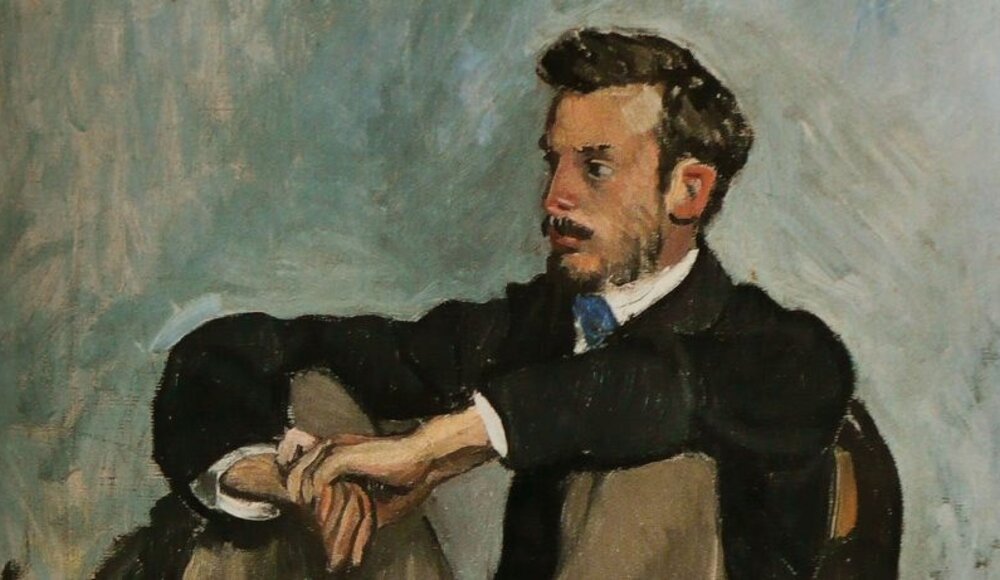
 Selena Mattei
Selena Mattei